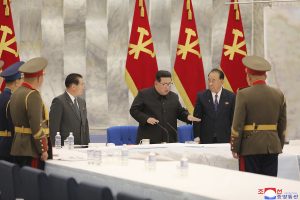North Korea’s state media Korea Central News Agency (KCNA) reported on Thursday that the second day of the third Enlarged Meeting of the Eighth Central Military Commission (CMC) of the Workers’ Party of Korea (WPK) was held on June 22.
“The respected Kim Jong Un, General Secretary of the Workers’ Party of Korea and Chairman of the Central Military Commission of the Party, guided the second-day sitting,” KCNA reported.
This meeting came a year after Pyongyang held its second Enlarged Meeting of the Eighth CMC in June 2021. Such meetings have normally lasted a single day. However, this week’s meeting was scheduled for more than two days, implying that major agenda items for Kim’s five-year military modernization plan were being discussed – possibly including the timeline and the details for North Korea’s seventh nuclear test.
The meeting “discussed issues on additionally confirming the operation tasks of the front-line units of the Korean People’s Army and revising operational plans according to the military strategic plan of the Party and on reorganizing major military organizations,” KCNA reported.
“Expressing the strategic view and decision of the Party Central Committee which is taking crucial military steps to enhance the operational ability of the front-line units, Kim Jong Un emphasized the importance of the work and made clear the principles, tasks and ways for the implementation,” KCNA said.
North Korean state media have not reported details on the issues and agendas Kim and his officials discussed during the meeting on Wednesday.
Washington and Seoul officials have warned that Pyongyang may conduct its seventh nuclear test at any time. Based on satellite footage monitoring Pyongyang’s restoration activities in its Punggye-ri nuclear site, outside experts also said it may test a nuclear device in the coming weeks or months.
Although the state media did not share the details of “the crucial military steps” to enhance the capabilities of “the front-line unit,” it has demonstrated that Pyongyang will not step back from the “strength to strength” power game with Washington, which has been implemented since the end of the failed Hanoi summit between then-U.S. President Donald Trump and Kim in 2019.
North Korea has already tested various ballistic missile programs this year, including intercontinental ballistic missiles (ICBMs), short-range ballistic missiles, reconnaissance satellites, hypersonic missiles, cruise missiles, and a submarine-launched ballistic missile. North Korea has already set a new record for the number of missile tests in a year – and it’s only June. Considering the spate of recent missile testing, Kim and his officials might have evaluated the missile tests with an eye toward deploying the tested missiles in the field.
Also, as the latest meeting was held on the same day that South Korea successfully launched a satellite into orbit with its first homemade rocket on Tuesday, Kim might have ordered his officials to set the timeline for a reconnaissance satellite test in the coming weeks as a corresponding measure. Washington viewed North Korean reconnaissance satellite tests in March as a cover for testing its new ICBM system.
It is also possible that Pyongyang could test its miniaturized nuclear warheads as one of “the crucial military steps” to enhance the capabilities of the front-line units.
Kim has reiterated his plan to deploy tactical nuclear weapons. During the military parade on April 25, Kim implied the possibility of using nuclear weapons as a preemptive strike option, not as a self-defense measure.
“Just as Kim conducted a nuclear test on February 13, 2013, after holding his first Enlarged Meeting of the Central Military Commission of the WPK days before the nuclear test, the seventh nuclear test is expected to be taken place soon after this Enlarged Meeting,” Cheong Seong-chang, director of the Center for North Korean Studies at the Sejong Institute in South Korea, told The Diplomat.
Thursday’s report by the KCNA included limited information on the outcomes of the meeting, but implicit nods to the seventh nuclear test could be found in the report, such as “revising operational plans according to the military strategic plan of the Party,” Cheong said.

































